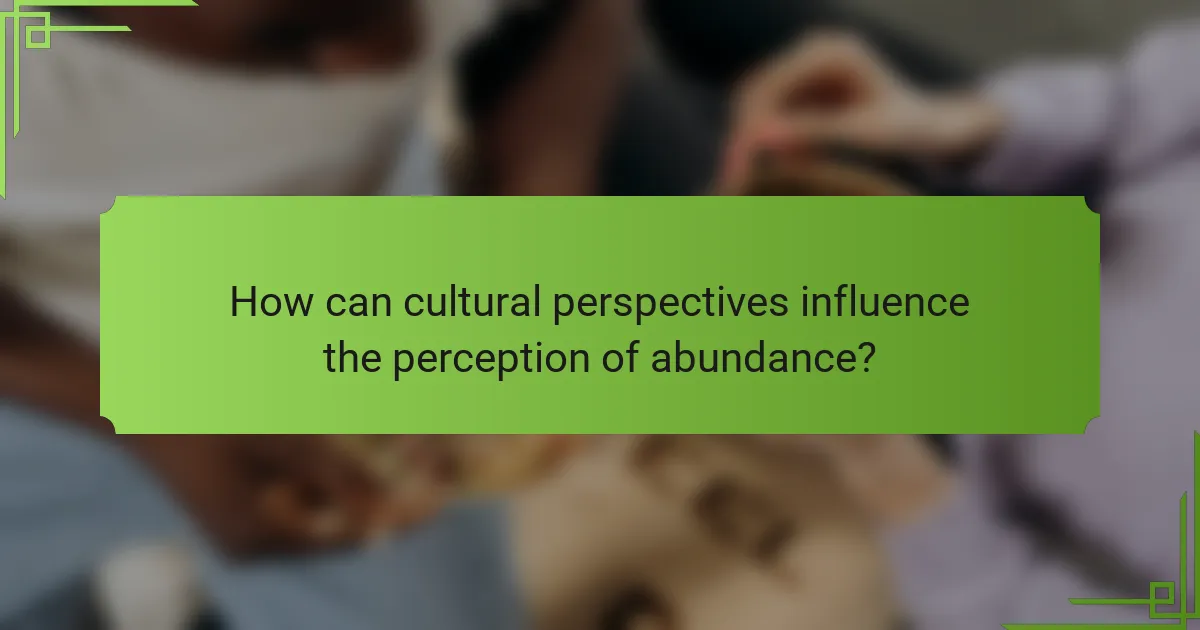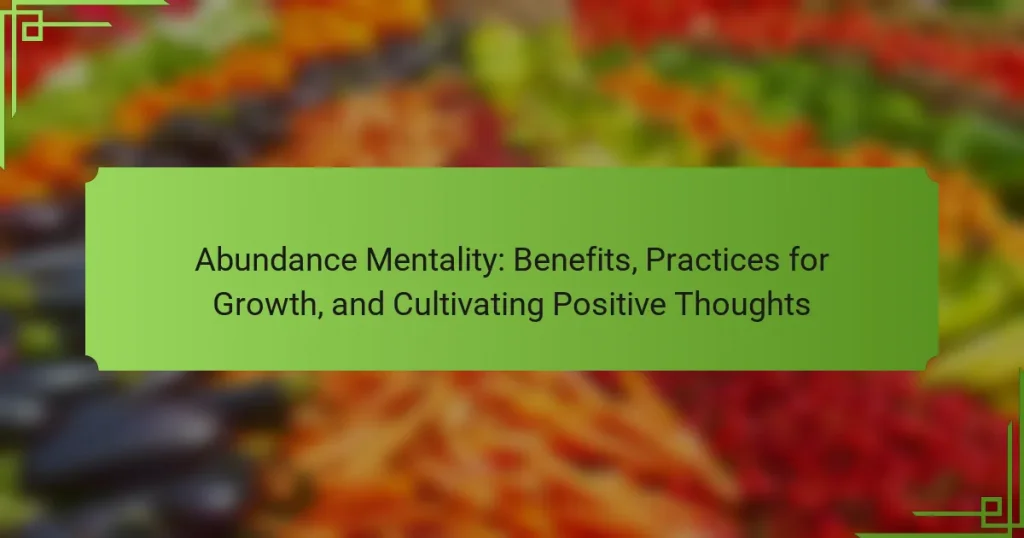An abundance mentality enhances overall well-being and fosters resilience. This mindset promotes creativity and strengthens relationships. Key practices include gratitude journaling, positive affirmations, and mindfulness. Cultural perspectives also shape how individuals perceive and cultivate abundance.

What is an abundance mentality?
An abundance mentality is a mindset that focuses on the belief that there are enough resources and opportunities for everyone. This perspective fosters collaboration, generosity, and a positive outlook on personal and professional growth. Benefits include enhanced creativity, improved relationships, and greater resilience in facing challenges. To cultivate this mindset, practices such as gratitude journaling, positive affirmations, and surrounding oneself with supportive individuals are effective. Embracing an abundance mentality can transform one’s approach to life, leading to more fulfilling experiences and achievements.
How does it differ from a scarcity mindset?
Abundance mentality focuses on opportunities and growth, while scarcity mindset emphasizes limitations and fear. This fundamental difference shapes how individuals approach challenges and relationships. Abundance encourages collaboration and sharing, fostering a sense of community, whereas scarcity breeds competition and isolation. Embracing an abundance mentality can lead to increased creativity and resilience, promoting a more fulfilling life.
What are the key characteristics of an abundance mentality?
An abundance mentality is characterized by a belief in the availability of resources and opportunities. Key characteristics include optimism, gratitude, collaboration, and a focus on growth. Individuals with this mindset see challenges as opportunities and prioritize sharing success with others. They practice positive thinking and maintain resilience in the face of setbacks.

What are the universal benefits of adopting an abundance mentality?
Adopting an abundance mentality fosters positivity and resilience, leading to numerous universal benefits. It enhances overall well-being by reducing stress and anxiety, encouraging a focus on opportunities rather than limitations. This mindset promotes creativity and innovation, as individuals feel empowered to explore new ideas without fear of scarcity. Additionally, it strengthens relationships by fostering collaboration and support, creating a community of abundance. Ultimately, embracing this mentality can lead to greater life satisfaction and fulfillment.
How does it enhance personal relationships?
Abundance mentality enhances personal relationships by fostering trust, empathy, and collaboration. It encourages individuals to focus on shared successes rather than competition. This mindset promotes open communication, leading to deeper connections. As a result, relationships become more resilient and supportive, creating a positive environment for growth and understanding.
In what ways does it improve mental health?
Abundance mentality significantly enhances mental health by fostering positive thinking and reducing anxiety. It promotes resilience, encouraging individuals to focus on opportunities rather than limitations. This mindset leads to increased happiness and life satisfaction, as individuals embrace gratitude and optimism. Research indicates that cultivating an abundance mentality can lower stress levels and improve overall emotional well-being, creating a more fulfilling life experience.
How can it lead to greater success in career and business?
Adopting an abundance mentality fosters greater success in career and business by enhancing collaboration and innovation. This mindset encourages individuals to see opportunities rather than limitations, leading to more effective problem-solving.
A study by the Harvard Business Review highlights that teams with an abundance mentality report higher levels of engagement and creativity. As a result, businesses can adapt more readily to changes and seize new opportunities. Cultivating this mindset promotes resilience, allowing individuals to navigate setbacks constructively.
Moreover, embracing an abundance mentality strengthens relationships and networks, creating a supportive environment for growth. This unique attribute of the abundance mentality can lead to increased productivity and overall success in professional endeavors.

What unique practices can cultivate an abundance mentality?
Adopting an abundance mentality involves unique practices that foster positivity and growth. Engaging in daily gratitude exercises enhances awareness of existing resources. Visualizing success and setting clear goals can create a roadmap toward abundance. Surrounding yourself with positive influences encourages a supportive environment. Practicing mindfulness helps to reduce scarcity thinking by promoting presence and appreciation. These strategies cultivate a mindset focused on possibilities rather than limitations.
How can gratitude journaling shift your perspective?
Gratitude journaling can significantly shift your perspective by fostering an abundance mentality. This practice encourages you to focus on positive experiences and acknowledge the good in your life, leading to increased happiness and reduced stress. Research shows that regularly writing about things you are grateful for can enhance overall well-being and promote a more optimistic outlook. By consistently reflecting on positive moments, you cultivate a mindset that appreciates abundance rather than scarcity. This shift not only improves mental health but also strengthens relationships and encourages personal growth.
What role does visualization play in developing this mindset?
Visualization plays a crucial role in developing an abundance mentality by enhancing focus and clarity on goals. It allows individuals to mentally rehearse positive outcomes, reinforcing belief in possibilities. This practice cultivates a mindset that embraces growth and opportunity, ultimately fostering resilience against challenges. Visualization techniques, such as guided imagery, can significantly improve motivation and self-confidence, essential attributes for nurturing an abundance mentality. As a result, individuals are more likely to attract positive experiences and opportunities in their lives.
How can affirmations be used effectively?
Affirmations can be used effectively by integrating them into daily routines and focusing on positive outcomes. Consistent practice enhances self-belief and fosters an abundance mentality. To maximize their impact, choose specific affirmations that resonate personally and repeat them with conviction. This process can rewire thought patterns, making positive thinking a habitual response.

What rare attributes contribute to a strong abundance mentality?
A strong abundance mentality is influenced by rare attributes such as resilience, gratitude, and openness to new experiences. Resilience allows individuals to bounce back from setbacks, reinforcing a positive outlook. Gratitude fosters appreciation for what one has, shifting focus from scarcity to abundance. Openness to new experiences encourages exploration and growth, creating opportunities for success. These attributes collectively enhance the ability to maintain an abundance mindset.
How does resilience enhance an abundance mindset?
Resilience significantly enhances an abundance mindset by fostering adaptability and optimism. When individuals face challenges, resilience allows them to view setbacks as opportunities for growth. This shift in perspective encourages positive thinking and reinforces the belief that resources and possibilities are plentiful. As a result, resilient individuals are more likely to cultivate an abundance mentality, leading to increased creativity and problem-solving skills.
What is the impact of community support on fostering abundance?
Community support significantly enhances an abundance mentality by fostering collaboration and shared resources. When individuals engage in supportive networks, they cultivate a mindset that emphasizes growth, gratitude, and possibilities. This shared encouragement leads to increased motivation and the exchange of ideas, which are essential for personal and community development. Studies show that communities with strong support systems report higher levels of individual well-being and collective success. By nurturing positive thoughts and practices, community support becomes a vital catalyst for fostering abundance in various aspects of life.

How can cultural perspectives influence the perception of abundance?
Cultural perspectives significantly shape how individuals perceive abundance. Different cultures emphasize various values, such as community, individualism, or spirituality, influencing their understanding of wealth and resources. For instance, collectivist societies often view abundance as shared prosperity, while individualistic cultures may focus on personal achievement. This cultural lens can lead to unique practices that cultivate an abundance mentality, such as gratitude rituals or communal sharing. As a result, individuals may develop varying attitudes toward wealth, impacting their overall well-being and growth.
What are common misconceptions about abundance in different societies?
Common misconceptions about abundance include the belief that it is solely about material wealth, that it promotes greed, and that it is unattainable for most people. Many societies equate abundance with financial success, overlooking emotional and spiritual richness. Some think an abundance mentality fosters competition, when in fact, it encourages collaboration and sharing. Additionally, the idea that abundance is a fixed state ignores its dynamic nature, which can grow through positive thoughts and practices.
How do local values shape the practice of abundance mentality?
Local values significantly influence the practice of abundance mentality by shaping individual perspectives and collective behaviors. These values encourage a mindset that prioritizes community support, resource sharing, and gratitude. For instance, communities that emphasize collaboration foster an environment where individuals feel empowered to adopt an abundance mentality. This cultural context enhances the understanding of opportunities and encourages positive thinking, leading to personal and communal growth. As a result, individuals are more likely to practice generosity and optimism, reinforcing the abundance mentality within their local environment.

What actionable steps can individuals take to cultivate positive thoughts?
Individuals can cultivate positive thoughts by adopting an abundance mentality, which emphasizes gratitude and growth. Start by practicing daily gratitude, focusing on what you appreciate in life. Engage in positive affirmations to reinforce self-belief and optimism. Surround yourself with supportive people who uplift your mindset and challenge negative thoughts. Set achievable goals to foster a sense of accomplishment and purpose. Lastly, practice mindfulness to enhance awareness of your thoughts and redirect negativity. These actionable steps can lead to lasting positive changes in your mindset.
What daily habits promote an abundance mentality?
Daily habits that promote an abundance mentality include practicing gratitude, setting clear goals, and surrounding oneself with positive influences. Engaging in mindfulness and visualization techniques also fosters a mindset of abundance. These practices enhance self-awareness and encourage a focus on opportunities rather than limitations.
What common mistakes should be avoided in this journey?
Avoiding common mistakes in cultivating an abundance mentality is essential for growth. Key pitfalls include negative self-talk, comparing oneself to others, and focusing on scarcity. Emphasizing gratitude and celebrating small wins can help counteract these tendencies. Overcommitting to practices without consistency can lead to burnout. Lastly, neglecting to surround oneself with positive influences can hinder progress.
How can one measure progress in adopting an abundance mindset?
Measuring progress in adopting an abundance mindset involves tracking shifts in thoughts and behaviors. Key indicators include increased gratitude, openness to opportunities, and reduced scarcity thinking. Journaling experiences, setting specific goals, and reflecting on positive changes can provide tangible evidence of growth. Regular self-assessment through mindfulness practices helps in recognizing these transformations.
What expert insights can guide the cultivation of an abundance mentality?
Cultivating an abundance mentality involves embracing positive thoughts and practices that foster growth. Expert insights emphasize gratitude, mindfulness, and collaboration as key practices. Gratitude shifts focus from scarcity to appreciation, enhancing overall well-being. Mindfulness encourages present-moment awareness, reducing negative thought patterns. Collaboration fosters community support, reinforcing the idea that success is not a zero-sum game. These practices collectively nurture an abundance mindset, promoting personal and collective growth.



